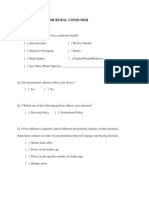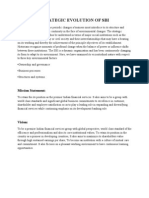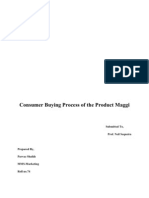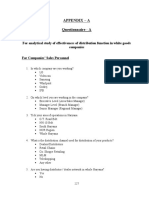MKTG Strategies For Rural Market
MKTG Strategies For Rural Market
Uploaded by
Anuja BhattacharjeeCopyright:
Available Formats
MKTG Strategies For Rural Market
MKTG Strategies For Rural Market
Uploaded by
Anuja BhattacharjeeOriginal Title
Copyright
Available Formats
Share this document
Did you find this document useful?
Is this content inappropriate?
Copyright:
Available Formats
MKTG Strategies For Rural Market
MKTG Strategies For Rural Market
Uploaded by
Anuja BhattacharjeeCopyright:
Available Formats
RURAL MARKETING
STRATEGIES
a) Segmentation of Rural Market
India has about 6,38,000 villages,50% of them are very
small having population of less than 500 persons with
limited purchasing power with many not having a single
shop.
The next category of villages are having population
between 501 persons to 2000 persons and are numbering
around 2.5 lakh villages.These villages are having around
five shops each.
But the companies should focus initially on villages with a
population of 2000 or more which are more than 60,000 in
number.FMCGs companies can cover 1,00,000 villages by
appointing 2000 stockists in towns of population of 20,000
Each and the stockists can conveniently distribute products to
50 locations around their towns.
The company can:
-Focus on select markets
-Focus on select makes
-Focus on select villages
b) Competitive Strategy
Companies interested in entering rural market can examine
their strategy on the conceptual Michael Porter's Five Force
model to develop strategy.
i) Supplier- A company should have good suppliers who can
provide good quality material or ingredients at a very low
price.
ii) Customer Power- The rural consumer,due to increased
liteacy,advent of television,promotional efforts & increased
contact with urban markets has become knowlegeable about
products.
Another primary customer,the retailer has a very high
bargaining power in the rural markets.But he only stocks few
brands per category as the rural consumer accepts whatever
is offered & is not very choosy.
The bargaining power of the retailer can be neutralised
through effectively executed promotional & brand building
efforts ,to create customer pull which results in the retailer
stocking a particular brand.
iii) Potential Entrants- Companies operating in the rural
market must raise entry barriers by being the first entrant in
the market & building good relations with the retailers so that
the chances of new entrants suurviving are low.
Usually new entrants,especially local & regional players
,offer lucrative terms to the retailers like more credit
period,low prices and margins.
iv) Substitute Products- Due to high level of illeteracyy,low
awareness & dependance on retailers,counterfeiting is
prevalent and cheap imitations flourish.
Companies have to ensure through packaging,promotion
and brand identity that rural consumers are educated about
Product.
Competiting with different substitutes for a product requires a
special approach and very different promotional message.
v) Competitors-The brands available in the rural market
rarely compete with each other and it is through the personal
influence of the retailer, that a particular brand is accepted by
the consumer.
c) Product Strategy-Marketers have to undertake product
mix modifications to suit the variables of rural markets.Escorts
was the first company to position its motorcycle'Rajdoot' as a
rugged vehicle for the rural terrain.
i) Understanding of the Valued Product: Value
consciousness is a big driver for the rural market and are
extremely aware of the equation of price,quality and
image.eg-Britannia came with the concep,"Swasth khao tan
man jagao".Thus Britannia was shown as a brand standing
for healthy food.
Videocon "washer",a washing machie without a drier,was
launched specifically for rural markets.Thus stripped down
Down versions of the urban products,which have features that
are as per needs of the rural consumers without the frills &
are priced low without compromising on the quality are the
ones that are more likely to succeed than the typical models
that are successful in the urban market.
ii)
Packaging:
The
affordability,storability,display
ability,availability along with the usage are the reasons for
rural consumers to choose smaller packs.
When brand loyalty is difficult to achieve & brand
identification is a big challenge in face of fakes &
counterferits,innovation in packaging becomes extremely
critical.These innovations in the form of pack sizes and colors
act as differentiator & can create demand-pull in the mind of
the consumers.
iii) Branding Strategy- In packaged goods industry,reduction
of the number of brands & creating a master brand to serve
many segments by product variety or brand extensions is a
strategic options adopted by many
players.
The high cost of building many brands is significantly
lowered if only few master brands have to be developed and
promoted for different but related products.
iv) Emotional Surplus Identity- ESI is a concept that
differentiates a corporate in a market of uniformity.
This analytical concept developed by Shining,equates a
corporation to a tree that aligns roots(corporate value) and
trunk(process) to deliver fruits(the deliverables of an
organisation)eg-Tata Salt-"Maine desh ka namak khaya hai" .
v) Logos & symbols- As most of the rural consumers do not
know English & most of the products are labelled in
English,the highlighting of logos & symbols can help them to
identify the brand for their final selection.
555 soaps,Monkey brand toothpowder,Gemini Tea with
elephant,Tortoise Mosquito Coil,Engine Mustard Oil,Ganesh
Mustard Oil are examples of using symbols and animals as
brand identifiers.
d) Pricing Strategy- Companies must follow the strategy of
penetration pricing with backup of a good quality product to
be successful in the rural market.
FMCG companies can cut cost to maintain the price points
through reducing the net weight of the product and doing
away with freebies and promotions.
Constant efforts should be undertaken to reudce capital
investments throughoutsourcing,manufacturing,streamlining
supply chains,actively managing receivables and monitoring
of performance of channel partners.
e) Communication Strategy- To communicate effectively
with the rural audience,it is important to understand the
aspirations,fears and hopes of the rural consumers ,in relative
to each product category,before developing a communication
package.The organisation has to think locally.
It is very important to invest in developing the specific & right
communication package aimed at the rural audience,if an
organisation expects to build a brand,in the rural market.
Some of the promotional strategies for the rural markets are
classified here under:
i) Education Instead of Promotion: The basic promise for
communicating a promotional mesage for the rural market is
that it has to be essentially an educational message.
Rural consumers has to be conveyed about how the benefits
delivered by the brand outweigh cost that he is going to incur.
The benefits that has to be projected should be in
accordance with the needs & lifestyles of the rural consumer.
The rural consumers entering the market for the first time for
many product categories need to be guided with regard to
usage & benefits of the products also.
ii) Customisation of the Promotional Message: Using
aspirational urban looking model but using simple and direct
communication which is not complicated,works well with the
rural audience.
The anchors conducting demonstration in rural areas need
to be trained in to speak in the local language or dialect
during
road shows so that they can connect better with the audience.
Tricky,clever,gimmicky or even suggestive advertising is not
clearly understood by the rural cosumer.
iii) Regionalisation of Advertisement: An in-depth study of
the mind-set of consumers of each region & for each product
category has to be undertaken.
Perceptions,traditions & values vary from state to state &
from region to region within a state.eg-Philips while
developing a rural campaign for their radios,for southern
India,developed
apunch
line
"Enga
Veetu
Super
Star",meaning "Superstar of my Home" basing on
Rajnikanth.For AP,the punch line developed was "Maa Inty
Mega Star" meaning Megastar of my Home meaning
Chiranjeevi.Philips also used the photograph of a village girl
besides the range of radios & transistors so that the rural
consumer could identify themselves with the range.
iv) Understanding Role of Mass Media: Mass media is the
most favoured medium for promotional activities.
TV is the most preferred medium with Doordarshan being
the network preferred,because of its wide reach in the
country.
According to the National Readership Survey,the print media
reaches about 23% of rural consumers in India,with 36%
having access to TV.
The mass media reaches about 57% of the rural population.
v) Outdoor Media Options:
a)Wall Paintings- Retailers have wall paintings of their
shops,walls & name boards and the paintings stay as long as
the weather allows it to.
b) Video Vans: Promotions using video vans create a lot of
word of mouth publicity for a brand in a region
Although,these vans have a very good potential to deliver
the intended comunication,they are costly to hire &
maintain.Thus,only the large organisations can afford these
vans.
The challenge is how to modify the audio-visual promotional
message according to the different languages & variations in
the dialects.
vi) Unconventional Platform to Promote Brands:
a) Mandis: These terminal markets have been set up by
state governments for procurement of agri commodities from
farmers.
These markets are generally located in agricultural area with
population of more than 10,000 on an average and cater to
1,36,000 people.
Cash rich farmers can be directly contacted by setting brand
stalls in mandis.
b) Haats: There are 42,000 haats each catering to the daily
needs of 10 to 20 villages.
The number of visitors on an average per hour is 4,500.
c) Melas: There are about 25,000 melas in India and 90%
are religious.
Melas provide a platform for communicating with rural
masses.
The female population of these villages who do not often
visit nearby towns are present in large numbers in these
melas.
Melas work best for introducing new brands & building
brands through the organisation of events at the venue.
Some of the widely visited melas include Kumbh Mela at
Haridwar,Allahabad,Ujjain,Nashik,Sonepur Mela in Bihar &
Pushkar Mela at Ajmer,Rajasthan.
d) Mills: It was found in a survey by MART of 24 villages
across UP & Punjab that around 200 tractors visit a mill in a
day during the peak season.
This gives an opportunity to target the farmers as they are
relatively free just waiting for their turn, will be receptive to the
demonstrations being given & may participate in interactive
sessions.
e) Pilgrim Sitesf) Rural Meets- Nearly one lakh spectators turn up to watch
the rural sports at Quila Raipur village for three days in
Punjab.
Rural games & tournaments are largely popular in rural
areas & are attended by the rural population in large
numbers.
These tournaments can be sponsored at a reasonable price
& can be utilised as a platform for brand building &
demonstrations.
The company's products can also be given for increasing
brand awareness.
g) Primary Health Centres:These centres are good
platforms where health & hygiene based products can be
sold.e.g.- Swasthya Chetna Campaign by HLL in rural areas
for promoting washing of hands would have directly or
indirectly promoted sale of Lifebuoy in the rural areas.
vii) Alternative Media for Rural Market: In rural India,there
are two distinct segments:
Rural rich & the middle class with aspirations,exposure to
mass media,with a lot of purchasing power.
Vast majority of illiterate masses who are poor & cannot be
reached easily through mass media.
For reaching the rich class,conventional mass media can be
utilised.
For reaching the less privileged class,unconventional
masses like nautanki,jatra,villupattu can be utilised in support
of conventional mass media.
viii)Folk Mediaa) Puppetry- In rural India,puppetry is an avenue for
entertainment & creative expression which can act asmeans
of
social
communication
&
vehicles
of
social
transformation.eg-LIC used puppets to educate rural masses
about the organisation in the villages of UP,Bihar & MP.The
number of enquiries at the local office of LIC immediately
following the performance as compared to the normal
frequency was found to be considerably higher.
b) Folk Theatre- This has been used as an effective medium
For popularising social issues and by the government for
informing about government sponsored projects for the rural
population.
c) Nautanki- It is a folk dance drama which is performed in
Uttar Pradesh on a make-shift stage & is a prime attractionin
the village fairs amongst all age groups because of its
narrative style & rustic flavour.
This media providescaptive audience & marketers can use it
as a platform for promoting their products as the rural
audience believes that performers are more credible than
conventional media.
d) Tamasha- It involves dance drama & interactive session
with
the
audience
which
comprises
of
only
males.Therefore,products meant for males can be effectively
promoted.
x) Innovative & Special Promotion Campaigns in Rural
Market- Some of innovative promotional campaigns are:
a) The scarecrow in fields can act as an advertising
campaign.
b) The mid-wife can be employed to promote baby care
products.
c)One on One Contact contact programmes provide an
opportunity to demonstrate the product & can induce trial.
Examples: TAFE Tractor launched a direct campaign to
strengthen the bond with existing customers through direct
contact exercise in 44 centres in 9 states.It resulted in sales
increasing by 12% after one month of campaign.
-When MRF decided to introduce bullock cart tyres with
nylon,it decided to call it " Pehelwan Chhaap Buggy Gaadi
Tyre".They organised nylon cord-breaking contest for the
'Pehelwan'.As nylon threads do not break,it effectively
demonstrated that MRF tyres comes with strength of nylon
that even the pehelwan cannot break.
-Ogilvy Rural conducted promotion programmes for 'Breeze',a
HLL brand which had Rose fragrance & was meeting
competition from Nirma Rose.To prove that Breeze contained
roses,the company employed a effective presentation.In the
interval of folk performances,it wheeled in an outsized bar of
'Breeze' made of thermocol on the stage,and the bar was
smashed.A heap of roses fell out of the bar,signifying that the
soap was indeed filled with roses and the message was
conveyed
e) Demonstrations: may be :
Method Demonstration -On Dalda's launch the company
organised frying of pakoras on street corners to convince
people that the medium can be used for frying.
Reckitt & Coleman educates customers about hygeine
aspects of Dettol vis-a-vis haldi.
A sugar cooperative in Kolhapur district had Hero,TVS &
Kinetic give a competetive demonstration so that an order for
400 mopeds could be placed.
f) Targeting Opinion Leaders- Rural consumers take a
buying decision after discussions with the opinion leaders.
The following play the role of opinion leaders for
advising on various product categories:
Successful Farmer/Agri-Extension
workers/Village Leaders-------- For Agri Inputs
Village Youth visiting the city---------For lifestyle
products
School Children------------For personal care
products.
eg-Asian Paints launched its Utsav range during
the Pre-Diwali season.The salesman selected the
opinon leaders in villages and painted the village
post office,the residence of the Pradhan to
demonstrate that the paint does not peel
off.Salesmen organised meets at the local
dealers,where village painters were invited.
f) Distribution Strategy :The marketer can adopt the
following strategies to make their products acceptable to the
rural market.
i) Ensuring Reach & Visibility :
Since a retailer can't afford to keep many different SKUs,it is
critical that a company's product should be first on the shelf
and develop a privileged relationship with the retailer.egMaggi noodles was the first to reach the shelves and is still
the market leader.
ii) Reaching upto Mandis/Towns/Semi-Urban centres:
There is a perspective that if the distribution reaches even
upto the feeder markets,it automatically finds its way down to
the rural market.
Iii) Targeting Larger Villages:
iv) Understanding the Peak Season:As peak seasons are
at different times in different parts of India,organisations can
focus their distribution energy for that period to that particular
region.Missing these times for a particular region is almost
equivalent to missing the year in that rural market for many
product categories.
The rural retailer considering the peak season could be
willing to stock more brands
The promotional campaigns at local & regional level can be
customised according to the theme of the festivity.
v) Delivery Vans: In order to move products in rural areas in
a cost effective manner,the organisation and distributors can
make use of rural makeshift transport vehicles known in
different areas in different names.
They are very cost effective and are very rugged to handle
the excessive wear and tear of the rural roads.
These vehicles are very popular in the states of UP,Punjab &
Haryana and can be available to companies to transport their
products in remote villages at a lower cost.Such vehicles
were used effectively by the rural sub-stockists of Coca-Cola
to distribute the soft drinks in the rural market.
vi) Collaboration for Distribution: Cost of setting up of a
huge retail network on one's own has its own intrinsic
problems like capital investment,close monitoring of the
channel partners and allied problems.Therefore,companies
collaborate to maintain distribution channels.eg-P&G had tie
ups with Godrej,Marico Industries and Nirma for distribution of
its brands.
These tie ups are of immense benefit for both the
organisations as one gets an immediate reach to million of
retail outlets & the other can leverage its distribution networks
over larger range of products & earn better returns on existing
networks.
Development of joint distribution infrastructure by noncompeting companies can reduce the cost of distribution per
organisation & these can make the operation viable.eg-JK
Dairy employed this strategy for distributing milk powder
satchets through three non-competing companies.
vii) Sales Women Network: eg-Project Shakti of HLL & TTK
group have employed women sales personnel for promoting
their products.
viii) Converting Unorganised Sector Manufacturers into
Distributors: Small or tiny scale manufacturers are finding it
difficult in face of intense competition from domestic &
international products to survive.
Organisations like Exide are attempting to convert these
small manufacturers as dealers in the unorganised sector in
Punjab & Haryana since they have good knowledge of the
territory & have good sales network,credibility & relationship
with the retailers & consumers.
ix)Company's
Own
Distribution
Network:Some
organisations are contemplating & testing their own
distribution network in order to promote their brands directly
to the retailers and consumers in the rural areas.eg-Rasna
Enterprises has built such a network in the rural areas of
UP,Rajasthan,Maharashtra,Gujarat & TN.
Dealership Education: The decision to buy a product is
made by the head of the family who has greater awareness
about a product available in the nearest town.
The dealer can influence the decision maker.
x) Continuous Availability of the Brand: The retailer can
influence a consumer in opting for another brand ,if their
preferred brand is not available.
This trial may result in the consumer shifting to the new
brand and there can be wider demand for the new brand as
the promotion spreads through word of mouth publicity.
This will make the retailer stock the new brand and drop his
previous brand resulting in the established brand regaining its
previous position.
Therefore,the organisatins need to ensure that their brands
are available at the retailer's shelves
on a regular basis.
'
xi) Quantity Discount for Rural Stockists: The distributors
rural stockists have to be provided with bulk discounts based
on the quantities purchased by them which will motivate them
to ensure that the products are marketed intensely in the rural
market.
For stockists not stocking products in larger quantities,they
can be provided with gifts or lucky coupons based
promotions.
g) Hiring Strategyh: The whole process of tapping the rural
market can be made effective,if the company hires
professionals
having
technical
rural
management
qualifications.The following characteristics are essential
requirements for a professional to effectively cater to the rural
population.
i) Fluency in Local Language : The salesperson selected
should have fluency in the local language so that they can
connect with the local population.
h) Social Strategies: Some of the social strategy initiatives
which could be adopted be the corporate world are as given
below:
i) Encouraging Primary Education in the Villages :to This
can be a key to influenceint people's behaviour.eg-HLL has
introduced such an effort in Maharashtra and believes that
this step will result in improving of sanitary habits & will create
awareness about personal hygiene & cleanliness which will
have a direct impact on their sales.
ii) Employment of Rural Youth:
Provision of employment opportunities in sales & distribution
in rural areas to local youths will increase the goodwill &
image of the company in the eyes of the villagers.
The rural youth will be in a better position to sell the product
after undergoing a sales training programme.
You might also like
- Organizational Culture of The Google CompanyDocument27 pagesOrganizational Culture of The Google CompanyMuddasir NishadNo ratings yet
- 42R-08 Risk Analysis and Contingency Determination Using Parametric EstimatingDocument9 pages42R-08 Risk Analysis and Contingency Determination Using Parametric EstimatingDody BdgNo ratings yet
- Sample Rural Marketing QuestionnaireDocument2 pagesSample Rural Marketing QuestionnaireSiddhant Puthran100% (1)
- Questionnaires For SupermarketDocument6 pagesQuestionnaires For SupermarketOnkarNo ratings yet
- PWC Winning in India Retail SectorDocument60 pagesPWC Winning in India Retail SectorsandipgargNo ratings yet
- Chapter 13: Consumer Decision-Making and Diffusion of Innovations (Pages 447-464)Document2 pagesChapter 13: Consumer Decision-Making and Diffusion of Innovations (Pages 447-464)raviNo ratings yet
- Self Reference CriterionDocument2 pagesSelf Reference CriterionJaemarie CamachoNo ratings yet
- Ge Case AnalysisDocument12 pagesGe Case Analysisapi-286007557100% (3)
- Case Studies in Strategic PlanningDocument214 pagesCase Studies in Strategic PlanningAnderson Ganem100% (6)
- WorkBook Unit 4Document5 pagesWorkBook Unit 4asheka campbellNo ratings yet
- BOA - Unit 2 - Creative AppealsDocument5 pagesBOA - Unit 2 - Creative AppealsAnjali NolkhaNo ratings yet
- Retail Marketing SegmentationDocument15 pagesRetail Marketing Segmentationmohammed nizar89% (9)
- Questionnaire For Rural ConsumerDocument7 pagesQuestionnaire For Rural ConsumerAnjali AgrawalNo ratings yet
- Rural Marketing Question Bank 2011Document4 pagesRural Marketing Question Bank 2011Vijay KumarNo ratings yet
- Difference B/W Marketing and Sales: Marketing Concept Selling ConceptDocument3 pagesDifference B/W Marketing and Sales: Marketing Concept Selling ConceptanishjohnaNo ratings yet
- Mba-Mk4 2023Document6 pagesMba-Mk4 2023Lalit SinghNo ratings yet
- An Empirical Study On Organic Products and Services at Organic Mandya - A Case Study With Special Reference To Mandya DistrictDocument8 pagesAn Empirical Study On Organic Products and Services at Organic Mandya - A Case Study With Special Reference To Mandya DistrictGowtham RaajNo ratings yet
- Challenges in Rural CommunicationDocument6 pagesChallenges in Rural Communicationgunashekar gouthamNo ratings yet
- Composite Models of Brand ValuationDocument1 pageComposite Models of Brand Valuationmailtoriteshpatnaik8255No ratings yet
- Market Segmentation in IndiaDocument35 pagesMarket Segmentation in Indiaarushi tanejaNo ratings yet
- Thompson Rural Market Index MAINDocument8 pagesThompson Rural Market Index MAINAnonymous d3CGBMzNo ratings yet
- Bba N 401 - Consumer Behaviour - Course CapsuleDocument5 pagesBba N 401 - Consumer Behaviour - Course CapsuleNupur Agarwal JainNo ratings yet
- Chapter 8. Sales QuotaDocument12 pagesChapter 8. Sales QuotaRahul upadhaya100% (1)
- BRM Study MaterialDocument21 pagesBRM Study MaterialLalithya Sannitha Meesala100% (1)
- Should MR Sharma Create A Separate Marketing Strategy For Rural MarketDocument3 pagesShould MR Sharma Create A Separate Marketing Strategy For Rural Marketsekhar_ntpcNo ratings yet
- Questions Carries 3 Marks: Investment Management Question BankDocument4 pagesQuestions Carries 3 Marks: Investment Management Question Bankchethan halandurNo ratings yet
- What Are Some Examples of HR Events at A B-School College FestDocument1 pageWhat Are Some Examples of HR Events at A B-School College Festgorika chawlaNo ratings yet
- of Surf ExcelDocument22 pagesof Surf Exceljanu882000100% (2)
- Future of Rural Marketing in IndiaDocument8 pagesFuture of Rural Marketing in IndiaPrashant Dabral0% (1)
- MQPs of Consumer Behaviour For AKTU MBA StudentsDocument3 pagesMQPs of Consumer Behaviour For AKTU MBA Studentsazam49No ratings yet
- Rural Marketing EnvironmentDocument3 pagesRural Marketing EnvironmentMahesh Bhansali0% (2)
- Sunsilk Gang of GirlsDocument16 pagesSunsilk Gang of GirlsRaunak JainNo ratings yet
- Consumer Co-Operatives in India PDFDocument7 pagesConsumer Co-Operatives in India PDFTapesh AwasthiNo ratings yet
- Rural Consumer BehaviourDocument13 pagesRural Consumer BehaviourAkhil Manoj100% (2)
- MKT Ca3Document5 pagesMKT Ca3Saqlain MustaqeNo ratings yet
- What Is The FMCG IndustryDocument4 pagesWhat Is The FMCG IndustryBraham GairolaNo ratings yet
- International Product Policy & Planning International Product MixDocument39 pagesInternational Product Policy & Planning International Product Mixarvind_pathak_483% (6)
- Opinion LeadershipDocument7 pagesOpinion LeadershipAnand SinghNo ratings yet
- Structure of Competition in Rural India...Document13 pagesStructure of Competition in Rural India...bhupesh_kushwahaNo ratings yet
- Max Final ProjectDocument76 pagesMax Final ProjectAvinash JosephNo ratings yet
- Symbiosis Institute of Business Management - Hyderabad Questionnaire-Branded ApparelsDocument3 pagesSymbiosis Institute of Business Management - Hyderabad Questionnaire-Branded ApparelsgunjanswaroopNo ratings yet
- Rural Marketing EnvironmentDocument16 pagesRural Marketing Environmentaparna kallaNo ratings yet
- Strategic Evolution of SbiDocument14 pagesStrategic Evolution of SbiGorang MuthaNo ratings yet
- Advertising and Sales PromotionDocument7 pagesAdvertising and Sales PromotionShailendra Srivastava100% (1)
- Economics of Industrial DemandDocument9 pagesEconomics of Industrial DemandALEXANDREA GUILLERMO100% (1)
- Service MarketingDocument3 pagesService MarketingAnindya ChandraNo ratings yet
- Assignment-Paid Owned Earned Media Framework: Digital MarketingDocument7 pagesAssignment-Paid Owned Earned Media Framework: Digital MarketingRanjana KejariwalNo ratings yet
- SCBADocument31 pagesSCBAraggarwal101No ratings yet
- SynopsisDocument8 pagesSynopsisAkhin SanjuNo ratings yet
- BMDocument11 pagesBMprasru 37No ratings yet
- Assignment On Consumer Buying Process For The Product Maggi NoodlesDocument17 pagesAssignment On Consumer Buying Process For The Product Maggi NoodlesParvaz Shaikh40% (5)
- Effectiveness of Distribution Channel Questionnaire Shodhganga PDFDocument13 pagesEffectiveness of Distribution Channel Questionnaire Shodhganga PDFpradeepNo ratings yet
- LenkskartDocument13 pagesLenkskartsrikar naredlaNo ratings yet
- Indian Marketing EnvironmentDocument9 pagesIndian Marketing EnvironmentRaju VeluruNo ratings yet
- National Seminar On Entrepreneurial Thinking: A Paradigm ShiftDocument2 pagesNational Seminar On Entrepreneurial Thinking: A Paradigm ShiftVineet ChouhanNo ratings yet
- CremicaDocument23 pagesCremicaParitosh SachdevaNo ratings yet
- Literature ReviewDocument5 pagesLiterature ReviewGauravsNo ratings yet
- Model Questionnaire A Study On Customer Preference To Dio's Scooter With Special Referece To Kamala Honda CoimbatoreDocument3 pagesModel Questionnaire A Study On Customer Preference To Dio's Scooter With Special Referece To Kamala Honda CoimbatorepecmbaNo ratings yet
- Green Products A Complete Guide - 2020 EditionFrom EverandGreen Products A Complete Guide - 2020 EditionRating: 5 out of 5 stars5/5 (1)
- Key Influencors StrategyDocument20 pagesKey Influencors StrategyNikhil SinhaNo ratings yet
- RuralDocument13 pagesRuralsridhar107No ratings yet
- Size of Rural MarketDocument6 pagesSize of Rural MarketSushant JaiswalNo ratings yet
- Rural Marketing Strategies in India Recent TrendsDocument10 pagesRural Marketing Strategies in India Recent TrendsAbhay KumarNo ratings yet
- Rural Retail Channel MGMTDocument8 pagesRural Retail Channel MGMTAnuja BhattacharjeeNo ratings yet
- Rural Consumer BehaviourDocument3 pagesRural Consumer BehaviourAnuja BhattacharjeeNo ratings yet
- CRM in Aviation Industry by JithendraDocument20 pagesCRM in Aviation Industry by JithendraAnuja BhattacharjeeNo ratings yet
- ILP Projects, PGDM 2013-15: General Project RequirementsDocument1 pageILP Projects, PGDM 2013-15: General Project RequirementsAnuja BhattacharjeeNo ratings yet
- Banking Finance Macroeco PDFDocument94 pagesBanking Finance Macroeco PDFAnuja BhattacharjeeNo ratings yet
- Ilp Continous Assessment ProjectDocument7 pagesIlp Continous Assessment ProjectAnuja BhattacharjeeNo ratings yet
- Institution Visit, AirportDocument1 pageInstitution Visit, AirportAnuja BhattacharjeeNo ratings yet
- SHRM Course OutlineDocument18 pagesSHRM Course OutlineFAIQ KHALIDNo ratings yet
- Renfrew County Community Study Executive SummaryDocument24 pagesRenfrew County Community Study Executive SummaryShawna BabcockNo ratings yet
- MBA Year 1 PH Semester 2 PH July 2021 SpecialDocument41 pagesMBA Year 1 PH Semester 2 PH July 2021 SpecialKhomo MalwaNo ratings yet
- 0919 - C4 - Management and Theory To Resorts P1Document30 pages0919 - C4 - Management and Theory To Resorts P1胡天超No ratings yet
- Credit Risk Management SbiDocument33 pagesCredit Risk Management SbiAmit Pasi50% (2)
- People and Profit: - A Practical Guide To Corporate Social ResponsibilityDocument188 pagesPeople and Profit: - A Practical Guide To Corporate Social ResponsibilityParinti ClujeniNo ratings yet
- Ending Homelessness, Rebuilding Lives: A Five Year Strategy For ST Mungo's 2016-21Document20 pagesEnding Homelessness, Rebuilding Lives: A Five Year Strategy For ST Mungo's 2016-21Alan SultanNo ratings yet
- Chapter 2 - Environmental AnalysisDocument41 pagesChapter 2 - Environmental AnalysisArslan Saleem100% (1)
- Context of The OrganizationDocument23 pagesContext of The OrganizationIbrahim SirpiNo ratings yet
- Honda Bikes Project ReportDocument27 pagesHonda Bikes Project ReportSneha SureshNo ratings yet
- Rose CompanyDocument8 pagesRose Companyravina10008100% (1)
- Automotive IndustryDocument23 pagesAutomotive IndustryJohn Dy100% (1)
- ch2 Service Strategy (No A)Document43 pagesch2 Service Strategy (No A)Jacky changNo ratings yet
- FMS 427 BusinessPolicy1Document279 pagesFMS 427 BusinessPolicy1Adeniyi Adedolapo OLanrewajuNo ratings yet
- ConsultancyDocument45 pagesConsultancyAnna Marie DayanghirangNo ratings yet
- Presentation - Group 4 - ManagementDocument10 pagesPresentation - Group 4 - ManagementEgia Arum TaptaNo ratings yet
- Marketing Mix of International Business MachinesDocument35 pagesMarketing Mix of International Business MachinesMuhammad Amjad Khan100% (2)
- PPAM Final NotesDocument51 pagesPPAM Final NotesShimels ShitayeNo ratings yet
- Strategic Analysis and Strategic Planning For Commercial Banking An Analysis Based A Commercial Bank Operating in Sri Lanka 2162 6359 1000418Document11 pagesStrategic Analysis and Strategic Planning For Commercial Banking An Analysis Based A Commercial Bank Operating in Sri Lanka 2162 6359 1000418thariNo ratings yet
- Full Text 02Document87 pagesFull Text 02JaucafoNo ratings yet
- Management Information System: Case Study ofDocument7 pagesManagement Information System: Case Study ofAnonymous YSA8CZ0Tz50% (1)
- Unit Information Form (UIF)Document10 pagesUnit Information Form (UIF)Naresh Ramratan0% (1)
- Turnaround StrategiesDocument29 pagesTurnaround StrategiesPratik PrakashNo ratings yet
- Icma.: PakistanDocument2 pagesIcma.: PakistanChisti BrothersNo ratings yet
- GOOD Darwin ReportDocument187 pagesGOOD Darwin ReportdarrelsilvaNo ratings yet
- Chapter 1 - What Is StrategyDocument59 pagesChapter 1 - What Is StrategyAlex RossiNo ratings yet
































































































